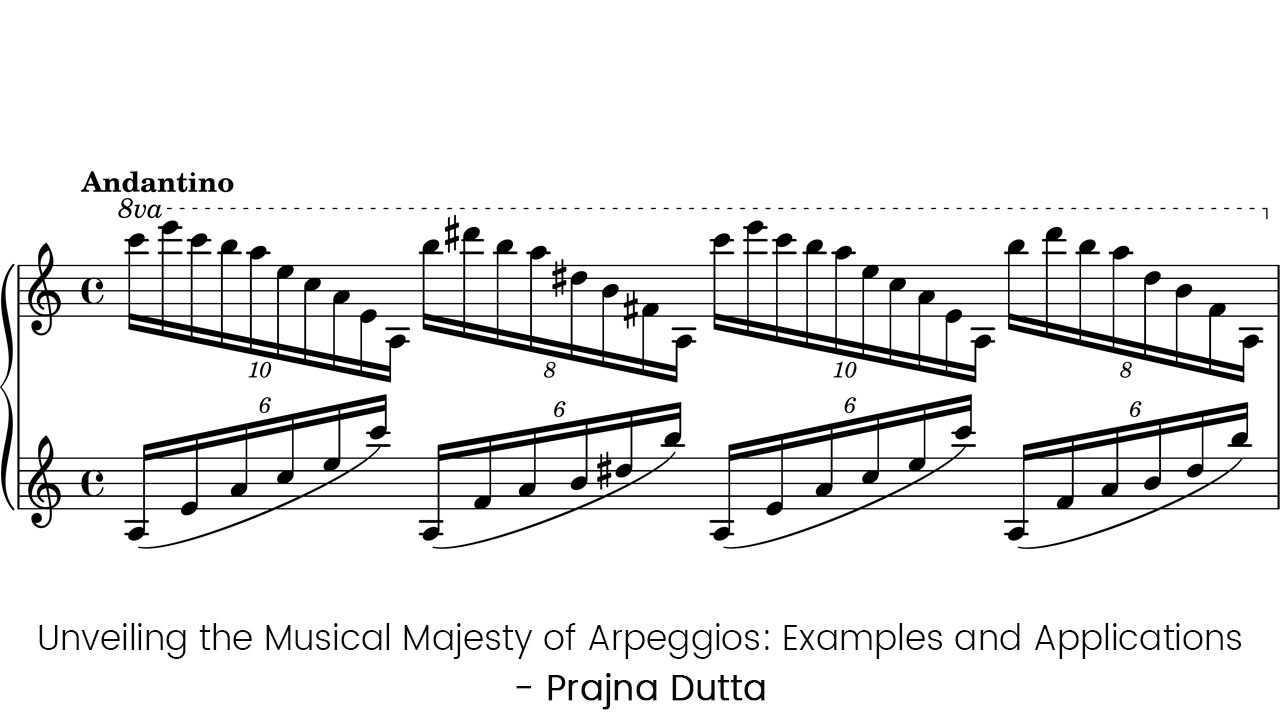Introduction:
In the vast realm of music, arpeggios have established themselves as a fundamental building block, infusing compositions with a touch of elegance and sophistication. Derived from the Italian word "arpeggiare," meaning "to play on a harp," arpeggios are melodious sequences of notes from a chord played in a broken pattern. This article aims to delve into the captivating world of arpeggios, exploring their significance, diverse applications, and providing examples of their usage across different musical genres.
The Essence of Arpeggios:
Arpeggios serve as a means to highlight the individual notes within a chord, allowing them to resonate with distinct clarity. By breaking the chord and playing its notes sequentially, arpeggios create a cascading effect that adds depth and texture to a musical piece. They possess a unique ability to captivate listeners, evoking emotions ranging from nostalgia to excitement, and can be found in a variety of musical styles, including classical, jazz, rock, and pop.
Classical Arpeggios:
Classical music is renowned for its intricate compositions and arpeggios play a crucial role in conveying its grandeur. One prime example is Johann Pachelbel's "Canon in D," where the arpeggiated chords form the backbone of the composition, creating a mesmerizing and timeless melody. Similarly, Frédéric Chopin's "Études" showcase the virtuosity of arpeggios, with pieces like "Étude Op. 10, No. 3" demonstrating the fluidity and grace that can be achieved through arpeggiated patterns.
Jazz and Blues Arpeggios:
Arpeggios are an essential tool in jazz improvisation, allowing musicians to explore harmonic possibilities and create captivating solos. Jazz guitarists often employ arpeggios to outline chord progressions, adding color and complexity to their improvisations. In pieces like Miles Davis' "So What," John Coltrane's "Giant Steps," or George Gershwin's "Summertime," arpeggios are used extensively to weave intricate melodic lines and showcase the harmonic richness of jazz.
Rock and Pop Arpeggios:
Arpeggios are not limited to the classical and jazz genres; they have found their place in rock and pop music as well. They can be heard in iconic guitar-driven songs, such as Led Zeppelin's "Stairway to Heaven," where the arpeggiated intro sets a mystical and haunting tone. Another notable example is The Beatles' "Blackbird," where Paul McCartney's fingerpicked arpeggios create a delicate and intricate accompaniment to the song's lyrical narrative.
Contemporary Applications:
Arpeggios continue to evolve and find new applications in contemporary music. In electronic dance music (EDM), arpeggiators—software or hardware tools—automate the process of playing arpeggios, creating pulsating and rhythmic patterns. Artists like Daft Punk, Avicii, and Deadmau5 have utilized arpeggios to craft infectious hooks and driving electronic arrangements, adding a modern twist to this timeless musical element.
Conclusion:
Arpeggios, with their enchanting broken chord sequences, have proven their versatility across a wide range of musical genres. From the classical compositions of Pachelbel and Chopin to the improvisations of jazz legends and the iconic riffs of rock and pop, arpeggios have left an indelible mark on the music we love.
The beauty of arpeggios lies in their ability to add depth, texture, and emotion to a musical piece. They allow musicians to explore the harmonic intricacies of chords, highlighting individual notes and creating a sense of movement and fluidity. Whether played on a piano, guitar, or synthesizer, arpeggios have a captivating effect on listeners, drawing them into the musical journey.
Aspiring musicians can benefit greatly from incorporating arpeggios into their playing. By mastering the art of arpeggiation, they can elevate their compositions, arrangements, and improvisations to new heights. Practicing arpeggios not only enhances technical skills but also deepens one's understanding of music theory and harmony.
When experimenting with arpeggios, musicians have various options to consider. They can choose to play arpeggios ascending, descending, or in various rhythmic patterns. They can also experiment with different chord voicings and inversions to create unique sonic landscapes. By combining arpeggios with other melodic and rhythmic elements, musicians can craft intricate musical tapestries that leave a lasting impact.
Arpeggios also offer a platform for personal expression and creativity. By experimenting with dynamics, articulations, and phrasing, musicians can infuse their arpeggios with their unique musical voice. This ability to personalize arpeggios allows artists to create memorable performances and leave their own artistic imprint on a piece of music.
In conclusion, arpeggios are a powerful musical tool that transcends genres and time periods. From classical masterpieces to contemporary compositions, their melodic allure enhances the emotional resonance of music. By exploring arpeggios and incorporating them into their playing, musicians can unlock a world of musical possibilities and captivate audiences with their artistry. So, let the arpeggios dance, and let the magic of broken chords continue to enchant and inspire us in the realm of music.

Comments